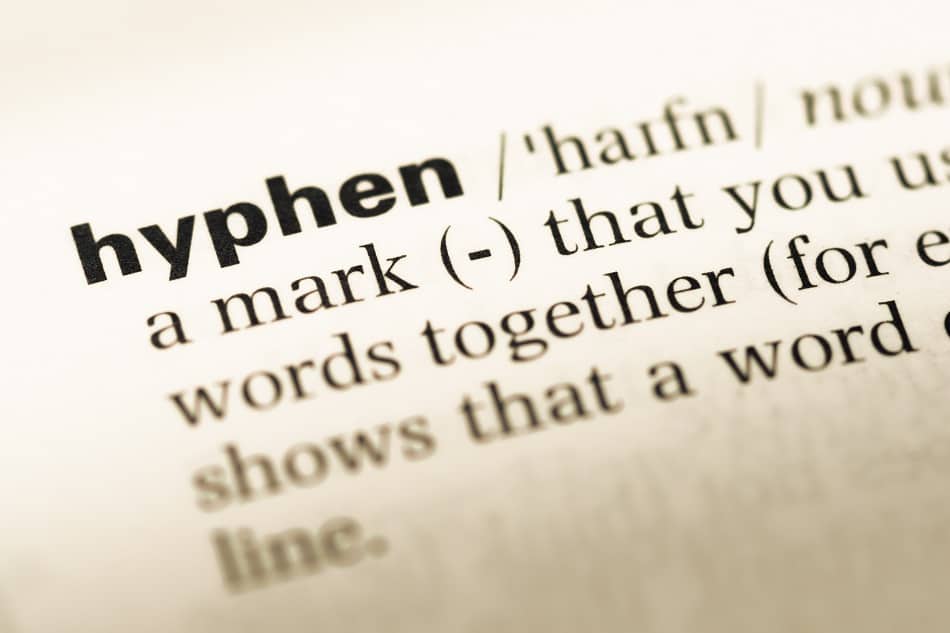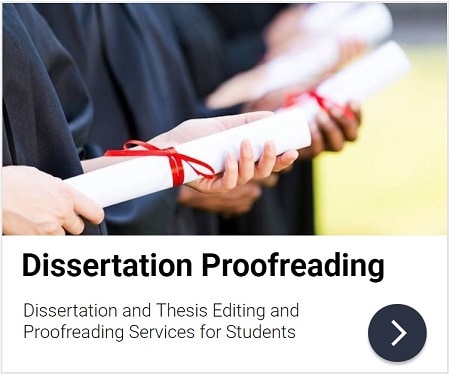5.2 The Perils of Hyphenation
Hyphens may seem too small an element of writing to warrant the term ‘perils,’ but a consistent system of hyphenation can be incredibly tricky to establish because the use of hyphens often depends upon the context of a word or phrase – namely, its specific role and its position in a sentence. Some disciplines will have conventional patterns of usage, so you may be provided with guidelines that indicate how and when hyphens should be used, but this is rare and it is more common for style guides simply to recommend that hyphenation be kept to a minimum. This is good advice because, although some hyphenated terms are traditional, hyphens tend to be used to clarify an author’s meaning, and excessive hyphenation can defeat this purpose as well as looking ‘fussy and dated’ (Ritter, 2005, Section 3.3.3). In addition, correct hyphenation patterns in English can vary from term to term and there is a tendency for hyphenated compounds to become closed with frequent use over time (the change from ‘on line’ to ‘on-line’ to ‘online’ is a good example), though, as a general rule, hyphens are used more extensively in British than in American English, so a good dictionary that provides some advice on hyphenation in one or both forms of the language is essential for looking up individual words and compounds. Beyond focussing on accepted patterns and clarity of meaning when using hyphens, you should ensure that each hyphenated element remains consistent throughout your thesis and that similar words and phrases used in similar ways feature similar hyphenation as much as this is possible and sensible, but do keep in mind that some compound terms will need to be hyphenated while other similar ones may not.
The following points outline effective uses of hyphens in formal English prose:
- Hyphens are used when compound numbers are written out as words: ‘thirty-six’ and ‘seventy-four.’ Although they are often used between the numerals in number ranges, especially for page numbers (pp.34-37) and numerical references (1,3-6,8-11), this is not strictly correct, and en rules are a better choice (‘pp.34–37’ and ‘1,3–6, 8–11’; see Section 5.6.4 below on en rules). However, university guidelines (or the style guides recommended by them) may indicate that page ranges should use hyphens instead of dashes (many guidelines do); if this is the case, you should use them consistently. Hyphens should always be used instead of en rules to separate noninclusive numbers such as telephone numbers: ‘1-888-755-3691’ (for more information on formatting numbers, see Section 6.4 below).
- Hyphens are used to separate letters when words are spelled out (e.g., ‘the last name is Fergusson – that’s F-e-r-g-u-s-s-o-n’), and they can also be used to indicate stammering or a pause in speech (I’m so f-f-frightened).
- A hyphen is used to indicate the omission of a common element when two or more similar compound terms appear close together, in which case the hyphen before the omitted element is followed by a space, as in ‘left- and right-handed’ or ‘upper- and lowercase.’ If the compounds are unclear or potentially ambiguous, however, each word should be written out in full, and the principle should definitely not be applied to the last in a sequence of such terms: that is, ‘uppercase and lower-’ is incorrect. The principle also does not apply when it is the first part of the compound terms that is shared, so ‘overindulged and -paid’ is incorrect and should be worded ‘overindulged and overpaid’ (see also my comments on prefixes below).
- A hyphen is used in the double-barrelled name of a single individual (the scholar’s last name is Kerby-Fulton), but for compound nouns and adjectives derived from two names, an en rule is appropriate (the Mann–Whitney test). In adjectives of this sort, a hyphen can be (and often is) used instead of the en rule (Marxist-Leninist), and a hyphen should always be used when the first element cannot stand alone, as in ‘Sino-Japanese.’ When a compound is formed from names that are already double, however, it is essential that the distinct uses of the hyphen and the en rule be maintained: for example, ‘Olson–Kerby-Fulton’ refers to two people, with the first named Olson and the second named Kerby-Fulton, but if a hyphen were used instead of the en rule, as in ‘Olson-Kerby-Fulton,’ or an en rule instead of the hyphen, as in ‘Olson–Kerby–Fulton,’ confusion would result (see also Section 5.6.4 below).
- Hyphenation is used for compass points in British English (‘north-west’ and ‘south-east’) but the same terms are closed in American English (‘northwest’ and ‘southeast’), though when an additional element is added it is followed by a hyphen in both: ‘north-north-west’ in British English and ‘south-southeast’ in American. Hyphens are not used in the names of winds based on compass points, which generally appear as closed single words (a northwesterly), and they are also not used in capitalised compounds based on compass points: ‘South East Asia,’ with the compound adjective open, is the form most often used in British English, for example, and ‘Southeast Asia’ the dominant form in American English.
- A hyphen can be used when a prefix is added to a word (pre-test), but the compound term can instead be closed (pretest). This can differ depending on whether British or American English is used, with American English using closed forms more often than British English. If the compound term does not appear in dictionaries, hyphenating it is the safest approach; if both forms appear in dictionaries, then either can generally be used as long as no confusion is created by the compound (‘re-create,’ for instance, does not mean the same thing as ‘recreate’). Problematic collisions of vowels without hyphenation should be avoided (in ‘re-establish’ and ‘anti-intellectual,’ for example, a hyphen should always appear), but there are exceptions: ‘cooperate’ and ‘coordinate,’ for instance, are usually closed. When a prefix is repeated, a hyphen should be used after the first instance (sub-subsection) and a hyphen should always be used when adding a prefix before a capitalised word or a date: ‘a non-English speaker’ and ‘post-1990s.’ A hyphen should also appear after a prefix added to a term that is already a hyphenated compound (non-self-indulging), but when the compound is an open one an en rule is used instead of a hyphen in American English (pre–Vietnam War). When a prefix appears alone a hyphen must be used to represent the missing word – ‘over- and undermagnified’ – and when ‘ex’ is used to indicate a previous state, it is usually followed by a hyphen (ex-husband). ‘Mid’ is a special case because it stands alone as an independent adjective in some contexts (mid sixteenth century), so while it, too, can form a closed compound, it is often followed by a hyphen even when other prefixes are not, as in ‘a mid-range property.’ A helpful list of prefixes and the terms formed with them, along with hyphenation notes, can be found in the Chicago Manual of Style’s guide to hyphenation (2003, pp.306–308), and see also the Publication Manual of the APA (2010, p.99).
- A hyphen can be used when a prefix is added to a word (pre-test), but the compound term can instead be closed (pretest). This can differ depending on whether British or American English is used, with American English using closed forms more often than British English. If the compound term does not appear in dictionaries, hyphenating it is the safest approach; if both forms appear in dictionaries, then either can generally be used as long as no confusion is created by the compound (‘re-create,’ for instance, does not mean the same thing as ‘recreate’). Problematic collisions of vowels without hyphenation should be avoided (in ‘re-establish’ and ‘anti-intellectual,’ for example, a hyphen should always appear), but there are exceptions: ‘cooperate’ and ‘coordinate,’ for instance, are usually closed. When a prefix is repeated, a hyphen should be used after the first instance (sub-subsection) and a hyphen should always be used when adding a prefix before a capitalised word or a date: ‘a non-English speaker’ and ‘post-1990s.’ A hyphen should also appear after a prefix added to a term that is already a hyphenated compound (non-self-indulging), but when the compound is an open one an en rule is used instead of a hyphen in American English (pre–Vietnam War). When a prefix appears alone a hyphen must be used to represent the missing word – ‘over- and undermagnified’ – and when ‘ex’ is used to indicate a previous state, it is usually followed by a hyphen (ex-husband). ‘Mid’ is a special case because it stands alone as an independent adjective in some contexts (mid sixteenth century), so while it, too, can form a closed compound, it is often followed by a hyphen even when other prefixes are not, as in ‘a mid-range property.’ A helpful list of prefixes and the terms formed with them, along with hyphenation notes, can be found in the Chicago Manual of Style’s guide to hyphenation (2003, pp.306–308), and see also the Publication Manual of the APA (2010, p.99).
- Hyphenation is more common when compounds act as modifiers or adjectives, particularly when the modifying compound precedes the noun it modifies. With the exception of proper names (such as ‘Great Britain’) and compounds formed from an adverb ending in ‘-ly’ and a following adjective (carefully engineered), hyphenation is never strictly incorrect, but it is not always required. There is a difference, for instance, between modifying compounds that contain an adjective (‘mass produced’ and ‘low level’) and compounds that contain nouns only (‘student nurse’ and ‘master mason’). Both types of compound modifiers can be hyphenated when they appear before nouns (‘a low-level executive’ and ‘a student-nurse position’), but while the first type should always be hyphenated, the second type does not strictly require a hyphen (e.g., ‘master mason John’ and ‘a student nurse position’). As a general rule, neither type of modifying compound requires hyphenation when it appears after the noun it modifies: ‘the book is well known,’ for instance, and ‘John is a master mason.’ Modifying phrases use the same general pattern of hyphenation when preceding a noun and an open structure when following the noun – ‘up-to-date research’ but ‘the research was up to date’ – although in some cases the most familiar phrases are hyphenated even when they appear after the noun: ‘her approach was matter-of-fact.’
- Hyphens are never used in certain compounds whether they appear before or after a noun. These include capitalised compounds (British Library manuscripts), compound scientific terms (sodium chloride solution) and adjectival compounds in which the first word is an adverb ending in ‘-ly’ (an environmentally sound policy). However, a hyphen is used in adjectival compounds when the second word is an adverb ending in ‘-ly,’ particularly when the compound appears before the noun it modifies (a user-friendly web site).
- As a general rule, hyphens should not be used in foreign phrases (‘an ad hominem argument’ or ‘a post hoc trial’) unless the hyphens appear in the original language (a tête-à-tête conversation). This policy is sometimes used for italicised foreign phrases only, in which case naturalised phrases appear in normal roman font and are treated like English phrases (see Section 6.2.2 on the use of special fonts).
- Hyphens are generally used in verbs formed from two-word noun compounds, so ‘to cross-reference’ is the verb derived from ‘a cross reference.’ Conversely, a noun formed from a phrasal verb is either hyphenated or one word (the verb ‘to back up’ thus becomes the noun ‘back-up’ or ‘backup’).
- Hyphens often appear in universal resource locators (URLs), as in the URL for the PRS web site (http://www.proof-reading-service.com/), where it is essential that they not be confused with underlining (_) or the tilde grapheme (~).
The lack of a general rule regarding hyphenation and the abundance of variant approaches leave hyphens (and the conscientious scholarly author) a little up in the air. In addition, the principles of hyphenation, like other elements of language, are fluid, so they tend to change. When capitalising hyphenated compounds in titles and headings, for example, it was once the case that only the first element bore an initial capital (Low-level Executive) unless the second element was a proper noun or otherwise required capitalisation, but the trend in the early twenty-first century is to capitalise both elements (Low-Level Executive) in titles and headings, particularly if full capitalisation is used for those titles and headings. A capital on the first element only still tends to be used at the beginning of sentences, however, or in titles and headings using minimal capitalisation, as in ‘Low-level executive’ (for more information on capitalisation, see Section 6.2.1).
‘Soft’ or ‘floating’ hyphens present different challenges. Whereas the ‘hard’ hyphens I have discussed above are deliberately and permanently positioned to join words or parts of words (or other elements such as numbers) in the formation of compounds, ‘soft’ hyphens are used to divide words at the end of the lines in a text to create a more balanced or attractive layout on the page. Soft hyphens are not necessary in a thesis and since they are generally added to a document through automatic hyphenation functions such as that in Word, which tend to introduce inappropriate and misleading divisions of words that are always unacceptable in formal prose, they are best avoided (‘exact-ing’ and ‘re-appear’ are acceptable divisions for ‘exacting’ and ‘reappear,’ for instance, but ‘ex-acting’ and ‘reap-pear’ are not: for a detailed discussion of the principles of word division, see Ritter, 2005, Section 3.4). Whether automatic hyphenation is used or not, however, words appearing in the columns of tables will sometimes become divided in nonsensical and distracting ways because the columns are too narrow to accommodate them (for example, ‘percentage’ incorrectly divided over three lines to read ‘perc-enta-ge’). In tables designed to report data in an immediately discernible visual form, this is unacceptable and unattractive, so do watch for it if you are including tables in your thesis. If necessary, use abbreviations, make the columns in the tables concerned a little wider to allow the words enough space or restructure the tables with plenty of room for the headings to appear in a legible fashion.
Why PhD Success?
To Graduate Successfully
This article is part of a book called "PhD Success" which focuses on the writing process of a phd thesis, with its aim being to provide sound practices and principles for reporting and formatting in text the methods, results and discussion of even the most innovative and unique research in ways that are clear, correct, professional and persuasive.
The assumption of the book is that the doctoral candidate reading it is both eager to write and more than capable of doing so, but nonetheless requires information and guidance on exactly what he or she should be writing and how best to approach the task. The basic components of a doctoral thesis are outlined and described, as are the elements of complete and accurate scholarly references, and detailed descriptions of writing practices are clarified through the use of numerous examples.
The basic components of a doctoral thesis are outlined and described, as are the elements of complete and accurate scholarly references, and detailed descriptions of writing practices are clarified through the use of numerous examples. PhD Success provides guidance for students familiar with English and the procedures of English universities, but it also acknowledges that many theses in the English language are now written by candidates whose first language is not English, so it carefully explains the scholarly styles, conventions and standards expected of a successful doctoral thesis in the English language.
Individual chapters of this book address reflective and critical writing early in the thesis process; working successfully with thesis supervisors and benefiting from commentary and criticism; drafting and revising effective thesis chapters and developing an academic or scientific argument; writing and formatting a thesis in clear and correct scholarly English; citing, quoting and documenting sources thoroughly and accurately; and preparing for and excelling in thesis meetings and examinations.
Completing a doctoral thesis successfully requires long and penetrating thought, intellectual rigour and creativity, original research and sound methods (whether established or innovative), precision in recording detail and a wide-ranging thoroughness, as much perseverance and mental toughness as insight and brilliance, and, no matter how many helpful writing guides are consulted, a great deal of hard work over a significant period of time. Writing a thesis can be an enjoyable as well as a challenging experience, however, and even if it is not always so, the personal and professional rewards of achieving such an enormous goal are considerable, as all doctoral candidates no doubt realise, and will last a great deal longer than any problems that may be encountered during the process.
Interested in Proofreading your PhD Thesis? Get in Touch with us
If you are interested in proofreading your PhD thesis or dissertation, please explore our expert dissertation proofreading services.


Services
PhD Dissertation Proofreading
Our PhD dissertation proofreaders specialise in improving grammar, sentence structure, citations, references, clarity, logical flow and readability.
Master’s Dissertation Proofreading
To avoid failure and its consequences, send your dissertation to our master’s dissertation proofreading service.
Scientific Dissertation Proofreading
Our scientific proofreaders specialise in correcting and perfecting the language, editorial styles and references across all science fields.
Headquarters
Dissertation-Proofreading.com
Allia Future Business Centre
The Guildhall
Market Square
Cambridge
CB2 3QJ
United Kingdom
More Expert Proofreading Services
Journal Editing
Journal article editing services
PhD Thesis Editing
PhD thesis editing services














